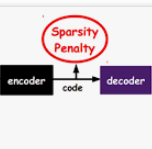The sparse coding algorithm has served as a model for early processing in mammalian vision. It has been assumed that the brain uses sparse coding to exploit statistical properties of the sensory stream. We hypothesize that sparse coding discovers patterns from the data set, which can be used to estimate a set of stimulus parameters by simple readout. In this study, we chose a model of stereo vision to test our hypothesis. We used the Locally Competitive Algorithm (LCA), followed by a na\"ive Bayes classifier, to infer stereo disparity. From the results we report three observations. First, disparity inference was successful with this naturalistic processing pipeline. Second, an expanded, highly redundant representation is required to robustly identify the input patterns. Third, the inference error can be predicted from the number of active coefficients in the LCA representation. We conclude that sparse coding can generate a suitable general representation for subsequent inference tasks. Keywords: Sparse coding; Locally Competitive Algorithm (LCA); Efficient coding; Compact code; Probabilistic inference; Stereo vision
翻译:稀有的编码算法作为哺乳动物视觉早期处理的模型。 假设大脑使用稀疏的编码来利用感官流的统计特性。 我们假设稀疏的编码从数据集中发现模式, 可以通过简单的读出来估计一套刺激参数。 我们在本研究中选择了一个立体视觉模型来测试我们的假设。 我们使用本地竞争性算法(LCA)来推断立体差异。 根据我们报告的三项观察结果, 首先, 差异的推论是成功的。 第二, 需要扩大的、 高度冗余的代表性来强有力地识别输入模式。 第三, 推断错误可以从 LCA 代表中的有效系数数中预测。 我们的结论是, 稀疏的编码可以为随后的推论任务产生适当的一般代表。 关键词: 斯帕瑟 coding; 本地竞争性阿尔戈里特姆(LCA); 高效的编译; 压缩代码; 精确性误判法; Sterepeopeo 。 我们的结论是, 稀疏误可以从LCEO 中预测出适当的一般代表。



